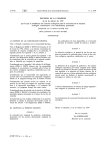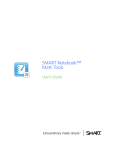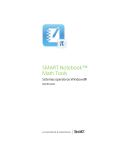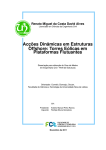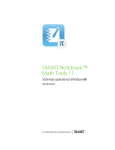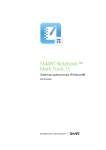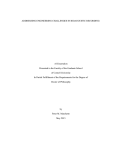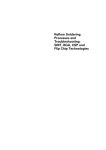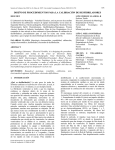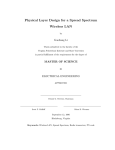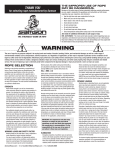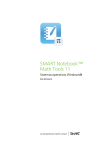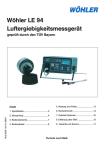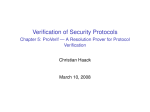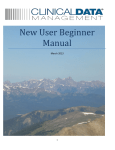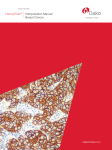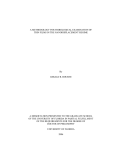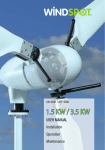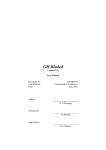Download Danish Energy Agency
Transcript
Danish Energy Agency Type Approval Scheme for Wind turbines Recommendation for Design Documentation and Test of Wind Turbine Blades 1st edition November 2002 INTRODUCTION ...................................................................................................... 3 SCOPE .................................................................................................................... 4 DEFINITIONS .......................................................................................................... 4 DESIGN DOCUMENTATION ..................................................................................... 7 4.1. Specifications................................................................................................ 7 4.2. Materials....................................................................................................... 7 4.3. External conditions and loads ...................................................................... 8 4.4. Strength analysis........................................................................................... 8 4.5. Deflection analysis ..................................................................................... 10 5. BLADE TEST ......................................................................................................... 12 5.1. Scope........................................................................................................... 12 5.2. Test laboratory ........................................................................................... 12 5.3. General ....................................................................................................... 12 5.4. Selection and identification of the tested blade .......................................... 13 5.5. Determination of natural frequencies and damping................................... 13 5.6. Static testing ............................................................................................... 15 5.7. Fatigue testing ............................................................................................ 16 5.8. Final static testing ...................................................................................... 19 5.9. Accuracy of test and measurements............................................................ 20 5.10. Verification of tests carried out at non-accredited laboratories............ 20 5.11. Reporting ................................................................................................ 21 6. COMPARISON BETWEEN DESIGN AND TEST RESULTS ............................................ 22 7. LIGHTNING PROTECTION ...................................................................................... 23 8. REFERENCES ........................................................................................................ 24 9. ANNEXES ............................................................................................................. 25 Annex 1. Recommended documentation ....................................................... 25 Annex 1 a. External conditions................................................................ 25 Annex 1 b. Blades .................................................................................... 26 Annex 1 c. Tests and measurements ........................................................ 27 Annex 1 d. Quality assurance/production ............................................... 27 Annex 1 e. Manuals ................................................................................. 27 Annex 2. Checklists for verification of blade tests ........................................ 28 Annex 2 a. Static blade test Check Sheet ................................................. 28 Annex 2 b. Fatigue blade test Check Sheet.............................................. 30 1. 2. 3. 4. Danish Energy Agency Type Approval Scheme for Wind turbines Recommendation for Design Documentation and Test of Wind Turbine Blades 1. Introduction This recommendation describes methods to fulfil requirements in “Technical Criteria for Type Approval and Certification of Wind Turbines in Denmark” [ref. 3]. The recommendation covers the wind turbine blade itself. Connections to blade bearing and hub are generally not covered, whereas parts integrated with the blade are included. This recommendation covers blades made of different materials. A technical committee, set up by the Advisory Board for Approval of Wind Turbines in Denmark, under the auspices of the Danish Energy Agency, has prepared the recommendation. The recommendation is based on existing codes and standards supplemented by best engineering practice and state of the art knowledge from experts who have been consulted in the process. Compliance with this recommendation does not exempt the manufacturer from product liability. The Danish Energy Agency and the authors of the recommendation cannot in any way be held responsible for possible failures that might be connected with the content or the application of the present document. Members of the Committee: Bente Vestergaard Jacob Wedel-Heinen Kaj Morbech Halling Ole Sønderby Jens Jørgen Kristensen Bernt Pedersen Povl Brøndsted Christian Leegaard Thomsen Carsten Skamris Egon T.D. Bjerregaard Det Norske Veritas, Danmark A/S Det Norske Veritas, Danmark A/S Vestas Wind Systems A/S NEG Micon A/S Bonus Energy A/S LM Glasfiber A/S Risø National Laboratory Risø National Laboratory Risø National Laboratory (editor) Risø National Laboratory Acknowledgement The members of the Committee are acknowledged for the big effort they have put into the creation of the recommendation during laborious meetings. Also the individuals in Denmark and abroad who have reviewed the draft version in the hearing process are acknowledged for their valuable comments. 3 Danish Energy Agency Type Approval Scheme for Wind turbines Recommendation for Design Documentation and Test of Wind Turbine Blades 2. Scope The scope of this recommendation is to give guidelines for fulfilling requirements concerning blade design and test of wind turbine blade in Technical Criteria [ref. 3]. 3. Definitions The relevant definitions in Technical Criteria [ref. 3] and IEC/TR 61400-23 [ref. 10] are applicable. For this recommendation the following definitions also apply: Edgewise Flapwise Flatwise Flatwise, edgewise, chord and thickness: Design loads are the characteristic loads multiplied with the load partial factor. See IEC 61400-1, section 7.6 [ref. 9]. Direction parallel to the local chord. (from IEC 61400-23). Direction that is perpendicular to the surface swept by the undeformed rotor blade axis. (from IEC 61400-23). Direction that is perpendicular to the local chord and spanwise blade axis. (from IEC 61400-23). See sketch below. Thickness Design loads Leading edge Web Flatwise Suction side Edgewise Trailing edge Pressure side Chord 4 Shell Danish Energy Agency Type Approval Scheme for Wind turbines Recommendation for Design Documentation and Test of Wind Turbine Blades Goodman diagram: Diagram showing fatigue limit as function of the mean load. A Different number of loadcycles M Mi σM σS σMi σA Lead-lag Pitch angle Pitch axis S is the mean value of the stress cycle. is the ultimate tensile strength. is the actual mean value of the stress cycle. is the amplitude of the stress cycle. Direction that is parallel to the plane of the swept surface and perpendicular to the longitudinal axis of the undeformed blade. (from IEC 61400-23). The angle between the tip chord of the blade profile and the rotor plane. Axis around which the blade pitches. 5 Danish Energy Agency Type Approval Scheme for Wind turbines Recommendation for Design Documentation and Test of Wind Turbine Blades R - ratio Minimum load divided by the maximum load in connection with cyclic loading. Definition of R-value Amplitude 2 1,5 1 0,5 0 -0,5 -1 -1,5 Tim e Series1 Web: Wöhler exponent Twist angle 6 Series2 In series 1 is the R value app. –1.0 In series 2 is the R value app. –0.1 Inner structure of the blade, which function normally is to transfer shear between the shells and raise the stability (buckling resistance) of the blade. The web can be a part of the load carrying structure. Slope of the fatigue line in the Wöhler diagram/SN curve (S – log(N) diagram) where: N is the number of load cycles S is the load, stress or strain Angle between chord and a fixed reference, normally the tip chord. Danish Energy Agency Type Approval Scheme for Wind turbines Recommendation for Design Documentation and Test of Wind Turbine Blades 4. Design documentation 4.1. Specifications The blade will be described with drawings, specifications and parts lists. Especially the following items should be described: • • • • • • • • • Geometry, profiles etc. Materials Laminate lay up Web- and shell designs Steel- and metal components Adhesive joints Cross section constants Net weight, centre of gravity and mass distribution Tolerances For more details, references is made to annex 1, specifying required documentation. 4.2. Materials The load carrying materials of rotor blades for wind turbines are usually made of fibrereinforced plastics or wood. The materials are typically made from E-glass and carbon fibres impregnated with a thermosetting resin (polyester, vinylester or epoxy). Blades made of wood are normally impregnated with epoxy. Material properties depend strongly on the fibre architecture and content, and the chosen processing route. Therefore, static and fatigue strength, and stiffness of the main load carrying parts should be measured on materials with a representative lay-up and a processing route similar to the blade in question. The purpose is to generate strength data for the demonstration of structural strength in section 4.4. Typically the blade consists of two shells giving the desired aerodynamic profile. The main part of the load carrying structure will normally be included in the shells. Between the shells and the beam one or more web(s) are normally inserted, often build as sandwich structures. The web(s) will support the shells against buckling and can also form a part of the main load carrying structure. Unsupported parts of the shells especially the large panels between the trailing edge and the rear web - are normally built as sandwich structures. The critical properties of the sandwich structure are the shear and compressive stiffness and strength (static and fatigue), which should be tested at normal and extreme conditions. Adhesive bonds should also be tested for sufficient static and fatigue strength at normal and extreme conditions. The strength of load transition areas where e.g. two materials of different stiffness are joined (steel bushing/fibre-reinforced laminate or glass/carbon laminate) or laminate ply drops should be tested prior to a full scale test of the blade in order to assure structural integrity of the final design. 7 Danish Energy Agency Type Approval Scheme for Wind turbines Recommendation for Design Documentation and Test of Wind Turbine Blades Making between five and ten tests on small specimens usually generates the static strength data of the materials. The characteristic strength can then be calculated according to DS456 [ref. 6] or DS409 [ref. 4]. When calculating the characteristic ultimate strength of materials, known standard deviation can be assumed, refer to e.g. DIN 55303, table 1 of part 5 [ref. 14]. Making between five and twenty tests on small specimens usually generates the fatigue strength data of the materials. Characteristic fatigue strength can be calculated according to e.g. the procedure described by Ronold and Echtermeyer [ref. 2]. Several other techniques can be used including e.g. the maximum probability method. In all cases it is advised that the load (or strain/stress) is taken as the independent variable. A number of experimental investigations on fibre-reinforced materials for rotor blades have shown that the fatigue strength, S, at a constant R-ratio can be described by the following equation S = K ⋅N −1 m , where K is a constant, N is the number of cycles to failure and m is a shape parameter (Wöhler exponent). The fatigue strength, S can be either on a strain, stress or load basis. The experimental data can be plotted in a log10S-log10N diagram and the above equation implies the following linear relationship log10 S = log10 K − 1 log10 N . m Fibre reinforced plastics cannot be assumed to have a fatigue limit, but will continue to degrade according to the equations above. Environmental conditions, which affect the material behaviour, should be considered and taken into account. Such conditions in particular include humidity and temperature, which may both lead to degradation of strength and stiffness. Their design effects calculated by dividing characteristic values by appropriate partial safety factors should be applied in the strength analysis. 4.3. External conditions and loads In general reference is made to Technical Criteria [ref. 3]. See also list of required documentation in annex 1. 4.4. Strength analysis 4.4.1. General Structural analyses of the rotor blades must be carried out for all relevant load cases in order to verify that the strength of the blades is sufficient to withstand the loads, which will be exerted on the blades. The strength calculations in these analyses must verify that both the ultimate strength and the fatigue strength, for a given design life, are sufficient. For structural parts in compression, stability must also be considered. 8 Danish Energy Agency Type Approval Scheme for Wind turbines Recommendation for Design Documentation and Test of Wind Turbine Blades For each load case, a set of design loads is established by multiplying the relevant characteristic loads by partial safety factors for load. The standards applied for this purpose should be quoted when the design loads are documented. In principle, each load case can be defined in terms of six load components and their variation over the blade span. The resolution used to specify this variation must be fine enough to allow for sufficiently accurate calculations in all points of interest along the blade, especially in all critical areas, e.g., wherever changes in geometry or material occur. The negative influences of allowed tolerances, fibre misalignments and workmanship shall be taken into account. Well-proven calibrated design tools and verified design codes must be used. Especially in cases of advanced computer programs such as finite element programs, it is important to tune or calibrate the results from use of the computer program models against results achieved from full-scale tests on rotor blades, so as to obtain models which best possible reflect reality. Loads on critical components such as tip brakes are often different in character from the general loads on the blades and may need extra attention. To summarise: special calculation may be necessary in the following blade sections: • Blade root • Root-blade transition • Tip brake system • Bonded joint between plastic/plastic and plastic/steel • Buckling of shells In some cases it may be necessary to prove the strength and rigidity of complicated substructures by means of separate full-scale tests. 4.4.2. Ultimate strength The safety of the blade must be determined in each section of interest along the blade. In general, the safety must be determined for flatwise and edgewise bending moments including combinations of these load components. The considerations and the chosen partial factors must be documented. 4.4.3. Stability The stability of a blade must be verified by a separate calculation, in addition to the fullscale test. For this calculation, a FEM analysis will normally be required. Furthermore, stability of the webs may also have to be considered. When designing for a stability it has to be ensured that the partial safety factor used also cover the following parameters: • • Type of instability Material stiffness 9 Danish Energy Agency Type Approval Scheme for Wind turbines Recommendation for Design Documentation and Test of Wind Turbine Blades • • • • Geometric imperfection Fibre misalignment Calculation method Workmanship The considerations concerning the influence of these effects on the design must be documented. 4.4.4. Fatigue Strength Fatigue safety must be considered in all critical sections. In each of these sections along the blade it must be verified that the fatigue strength is not exceeded. This is in practice done by checking that the Palmgren Miner’s sum, calculated for the design stress range histogram in conjunction with the design S-N curve, does not exceed a critical value, which is usually equal to 1.0. The effect of R on the S-N curve has to be considered. The assessment of the cumulative damage can be carried out by means of Goodman diagrams. 4.5. Deflection analysis A deflection analysis of a blade must be carried out. As a part of the deflection analysis it must be proven, for all load cases, that the ultimate tip deflection is acceptable. The clearance between the rotor blade and the tower should be determined by using the most unfavourable combination of geometrical tolerances and characteristic stiffness of the rotor blade and its supports. The clearance between the blade tip and the tower may be calculated through different methods. Depending on the methods used, a partial factor should be used taking the uncertainty of the particular calculation methods into account. According to ref [1] section 7.3.2 the distance between tower and the blade tip should comply with the following condition d 0 − γ ⋅ u max > F d0 umax γ 10 distance between the tower and the blade tip in the unloaded/undeflected condition maximum deflection of the blade considering all relevant load cases and based on characteristic load values and characteristic material properties partial safety factor on the maximum deflection of the blade, to be chosen according to Danish Energy Agency Type Approval Scheme for Wind turbines Recommendation for Design Documentation and Test of Wind Turbine Blades F the relevant load case requirement to the residual clearance between the tower and blade tip, usually 0.0 The definition of the safety factor γ depends on which set of standards is used for the critical blade deflection analysis. See also ref [9]. 11 Danish Energy Agency Type Approval Scheme for Wind turbines Recommendation for Design Documentation and Test of Wind Turbine Blades 5. Blade test 5.1. Scope The scope of a blade test is to verify the structural properties of a blade. By structural properties is meant: • • • • • 5.2. Mass and centre of gravity Stiffness distribution Natural frequency and damping Ultimate strength Fatigue strength Test laboratory The Danish Energy Agency authorises measuring laboratories to carry out blade tests. For further information concerning authorised measuring laboratories please contact: The Danish Energy Agencys’ Approval Scheme for Wind Turbines http://www.dawt.dk/ In the measuring laboratory’s list of methods the laboratory performing the test must refer to the present recommendation. In situations where it is not possible to have the blade tested by an accredited laboratory, the certifying body or an accredited laboratory must verify the test. 5.3. General The blade must be tested in a load-based test related to the design loads. Before a test is started up a detailed test plan must be prepared. It is strongly recommended to have the test plan approved by the certifying body prior to the start of a test. A wind turbine blade test includes the following elements: • • • • • Identification of the tested blade Determination of natural frequencies and damping Static strength test Fatigue strength test Final static strength test. The final static test is carried out in the same way as the initial static test. However possible removed part of the blade is not tested. During the test of the blade invisible damages may occur on the blade. The fatigue test in one direction may also influence the lifetime in the other direction. Given these facts it must therefore be the same blade that is subject to testing during the whole test. However, the test can be carried out on 2 blades where for instance all tests are carried out on the inner part of the first blade and on the outer part on the second blade respectively. 12 Danish Energy Agency Type Approval Scheme for Wind turbines Recommendation for Design Documentation and Test of Wind Turbine Blades General information about test procedures and evaluation of these tests may be found in IEC/TR 61400-23 [ref. 10]. In cases where IEC/TR 61400-23 can be used without reservations, the specific chapter will be referred in the following. 5.4. Selection and identification of the tested blade As only one specimen of a blade type is required for testing is it important that the specimen in question can be assessed to be representative for the later serially produced blade. In order to ensure the acceptable compliance between the tested blade and the serially produced blade, one of the following selection criteria if possible can be used: • • The certifying body or a body accredited to carry out blade manufacturing inspection witnesses the production of the blade in order to ensure compliance between the production and the production specification. This method is often used in connection with prototype blades. The blade is chosen at random from the production, for instance by the certifying body. It is recommended to consult the certifying body when selecting the blade for testing in order to clarify to which extent the tested blade can be regarded as being representative for the later serially produced blade. For identification of the blade in question the following data and measurements of the blade must be made: • • 5.5. Blade type and serial number Main dimensions of the blade as follows: o length o mass o centre of gravity(c.o.g) Determination of natural frequencies and damping Natural frequencies and structural damping must be determined. At least the following natural frequencies must be determined: • • • • 1st flapwise natural frequency 2nd flapwise natural frequency 1st lead – lag wise natural frequency 1st torsion natural frequency When measuring the natural frequency of a blade suspended in a test rig, the stiffness of the test rig will influence the result. This is mainly important if the test rig is flexible or a bearing is inserted between the test rig and the blade. The stiffness of the test rig and the resulting influence must be considered and evaluated. The structural damping must be determined for at least the following natural frequencies: 13 Danish Energy Agency Type Approval Scheme for Wind turbines Recommendation for Design Documentation and Test of Wind Turbine Blades • • 1st flapwise natural frequency 1st lead – lag wise natural frequency The aerodynamic damping contributes to the results of the measurements of damping, as the measured result is a combination of both aerodynamic and structural damping. The contribution from aerodynamic damping is highest when determining the damping in flapwise direction. It is therefore important to determine the damping with very small deflection of the blade. The maximum acceptable deflection of the blade tip depends on the natural frequency and the velocity of the blade. It is recommended to measure the vibrations over a period and evaluate from these measurements what may be the maximum acceptable deflection. The blade temperature will influence the determination of natural frequencies and well as damping. It is therefore important to know the structure temperature when determining frequencies and structural damping. This factor can be known by letting the blade obtain ambient temperature inside the test laboratory beforehand. Comment: The determination of natural frequencies and structural damping is normally done following the subsequently described method. The vibration mode that is subject for investigation is excited by hand. The movement of the blade is hereafter determined by means of an accelerometer mounted on the tip of the blade. The signal from the accelerometer is analysed by a computer or manually after plotting the signal. The torsion natural frequency is determined by means of two accelerometers mounted on the leading and trailing edges of the blade. Alternatively the natural frequencies and the structural damping can also be evaluated in connection with a modal analysis. In connection with a modal analysis also the mode shape of the vibrations will be determined. Modal analysis is recommended in connection with the verification of the input parameters for the aeroelastic codes used for calculation of the loads. Modal analysis is carried out as described below: A hammer with a force transducer mounted excites the blade. The responses are hereafter measured by means of accelerometers mounted at app. 10 different positions along the blade. The response function between the force transducer and the accelerometers can hereafter be determined by FFT analysis. The results of the measurements are besides natural frequencies and damping for several natural frequencies also the shape of the vibration. 14 Danish Energy Agency Type Approval Scheme for Wind turbines Recommendation for Design Documentation and Test of Wind Turbine Blades 5.6. Static testing As large a part of the blade as possible must be tested. This means that it is not acceptable only to test the parts, which are evaluated to have the largest stresses. The static test must be carried out in such a way that the blade is tested for all extreme load cases in each direction. This means that the blade must be tested in 5 directions as follows: • • • • • Flapwise direction from suction side to pressure side Flapwise direction from pressure side to suction side Lead - lag wise direction from trailing edge towards leading edge Lead - lag wise direction from leading edge towards trailing edge Torsion - only stiffness distribution are determined. This test may be omitted in case the stiffness is not critical for the design of the blade. Evaluation of combined load situations is done through calculations only. Alternatively, the loading may also be done as a combination of flap and lead - lag wise loads. Applying one or more load clamps to the blade and then pulling these load clamps in either vertical or horizontal direction normally constitutes the test of the blade. By loading in several positions simultaneously a more correct distribution of both bending and shear is obtained. However, when loading the blade in several positions the load clamps will contribute to the stability of the blade. The width of the clamps should therefore be as small as possible taking the surface pressure into account. When loading in horizontal direction, disturbances from the weight of the blade itself and the various load clamps will not affect the test. The deflection of the blade in flapwise direction can be very large. Consequently, the distance from the point of attack perpendicular to the induced force to any spot on the blade will vary during the test. This circumstance must be taken into account when determining the bending moment during the test in order to avoid influential errors. The blade must be tested to a load, which is higher than the design load. This is done in order to take influences from temperature, humidity, production (blade to blade variations) and other environmental aspects during the life of the blade into account. The test load will hereafter be: Test load = 1.1 × Design load The determination of design loads must be done according to DS472 [ref. 7]. The load must be applied either in tip chord direction or perpendicular to this. When no special instructions are given the load must be applied in the blade neutral axis. During the test the following must be registered or measured at either specified intervals or continuously: 15 Danish Energy Agency Type Approval Scheme for Wind turbines Recommendation for Design Documentation and Test of Wind Turbine Blades • • • • • • Strain in heavily loaded areas and areas with imperfections Deflection at the tip and a appropriate number places along the blade Possible buckling must be described Position, angle of attack and load at all load clamps Temperature Possible photos for the reporting Deflection of the test rig and its influence on the test results must be considered. At maximum load, the load must be maintained for a period of time, which as a minimum must be of the same length as the period of the extreme load. Also the time used for inspection of the blade must be taken into account in connection with the choice of maintaining period. In default of a specified period, a period of 10 s may be used. After the end of the static test a detailed inspection of the blade must be carried out. Possible damages must be reported. The results of this inspection together with measuring results and observations of possible buckling will lead to either acceptance or rejection of the blade. The following criteria can be used in connection with the assessment of the blade: Acceptable Features Criteria for Rejection Unidentified noise emerging during the test Total breakdown of the blade All cracks in gel coat Severe damage of load carrying laminates Cracks in Adhesive in areas without any load carrying effect Severe buckling in load carrying laminates which do not return to original shape when unloading Cracks close to load clamps which appear to come from overloading (for instance with shear stress) Any buckling at loads coming from load cases in normal operation. This could for example be a situation with a sudden change of wind direction at cut out wind speed Damages due to excessive surface pressure at the load clamps Damages which may clearly be identified as production errors and which after repair prove their strength by a supplementary test 5.7. Fatigue testing Fatigue testing can be carried out in different ways. In most cases one of the following methods is used: 16 Danish Energy Agency Type Approval Scheme for Wind turbines Recommendation for Design Documentation and Test of Wind Turbine Blades 1. Excitation of the blade at its natural frequency by means of a rotating unbalance fixed to the blade. When applying masses to the blade it is possible to load a major part of the blade to its design load. 2. Forced deflection of the blade by means of hydraulic activation or similar. As this method implies large requirements to the hydraulic system it is difficult to carry out the test at high frequencies. Only part of the blade will therefore be loaded to its design values when applying forces in one position only. However, determination of the applied forces is thus specified with less uncertainty. In order to apply the correct load distribution during the fatigue test it is often necessary to apply dead weight to the blade. Especially when using method 1 it is possible to apply a correct load distribution through applying 2 or 3 dead weights to the blade. Fatigue test in lead - lag wise direction combined with a static load in flapwise direction may also be made. Determination of design loads must be done according to DS472 [ref. 7]. The blade must be tested to the design load multiplied with a test partial safety factor according to IEC 61400-23 [ref. 10]. The test load must be: Ftest = Fequivalent × γnf × γsf × γef where Ftest is the test load Fequivalent is an equivalent load with a fatigue damage equal to the calculated fatigue damage in the design load spectrum. The equivalent load depends on the number of test load cycles. γnf is the partial factor for consequences of failure. The partial factor is 1.15. γsf is the blade to blade variation factor equal to 1.1. The factor may be increased or decreased depending on the blade production method or failure probability distribution data available. γef is a factor originating from possible errors in the fatigue formulation. The factor is equal to 1.05 and may be reduced when less uncertainty can be documented. The procedure for calculation of equivalent loads must be based on a numerical model for fatigue in the blade material for the main load carrying parts. The numerical model can be based on rain-flow counting and Palmgren-Miners rule. The model must consider the effect of mean stress on the fatigue life. The following items must be considered when planning the blade fatigue test and determining the test load and number of cycles: 17 Danish Energy Agency Type Approval Scheme for Wind turbines Recommendation for Design Documentation and Test of Wind Turbine Blades • • • • • The increase in load, which is required to accelerate the test, depends on the slope of the fatigue curve for the details tested. The slope of the fatigue curve m may vary from m = 3 to m = 15 for different details of a wind turbine blade and for different levels of the mean stress. Due to the variation in slope of the Wöhler curve some areas of the blade might not be sufficiently tested. These blade details which are left out of the scope of the blade fatigue test must be tested otherwise. To get to the largest extent of details covered in a blade fatigue test, a test series with more than one load level may be applied. The fatigue loads should not exceed the extreme static test loads. The fatigue damage model which is used for calculation of the equivalent loads must be verified with a sufficient number of tests approved by the certifying body on representative specimens within the range of mean strains and strain widths considered for the blade in the transformation from the design load spectrum to equivalent load. The tip of the blade can in some cases be removed from the blade to increase the natural frequency controlling the feasible number of load cycles in the test. The tip must be removed after the initial static testing. The tip must be thoroughly inspected (e.g. by cutting and visual inspection) to detect manufacturing defects that would require documentation for the impact on fatigue strength. Criteria for assessing the possibility of removing the tip of the blade can be found in IEC61400-23, sec. 6.6. The load must be applied either in tip chord direction or perpendicular to this. During the test the following must be registered or measured at either specified intervals or continuously: • • • • • Strain in heavily loaded areas and areas with imperfections Loads on the blade Number of cycles Temperature Possible photos for the reporting The measurement of strain during the test is mainly carried out in order to secure the correct load distribution during the test. The fatigue test set-up must be calibrated at periodical intervals during the fatigue test. During the calibration the stiffness as well as the strain as function of the bending moment is checked. If no other intervals are specified the following calibration intervals may be used: • • • • • 18 before start at 10,000 load cycles at 50,000 load cycles at 100,000 load cycles at 250,000 load cycles Danish Energy Agency Type Approval Scheme for Wind turbines Recommendation for Design Documentation and Test of Wind Turbine Blades • • • at 500,000 load cycles at each 1,000,000 load cycles hereafter after the end of the test It is recommended that, in agreement with the blade manufacturer, the test laboratory keep the certifying body informed of the results from the fatigue test during the test period. During and after the fatigue test a detailed inspection of the blade must be carried out. Possible damages must be reported. The results of this inspection together with measuring results will lead to either acceptance or rejection of the blade. The following criteria can be used in connection with the assessment of the blade: Acceptable Features Criteria for Rejection Unidentified noise emerging during the test Total breakdown of the blade All cracks in gelcoat Severe damage of load carrying laminates and adhesive connections Cracks in adhesive in areas without any load carrying effect Cracks close to load clamps which appear to come from overloading (for instance with shear stress) Damages which can clearly be identified as production error and which after repair prove their strength by a supplementary test It is recommended that the planned examination be carried out after agreement with the certifying body. 5.8. Final static testing After the fatigue test a final static test must be carried out. The object of this test is to verify that blade has not sustained any severe damage during the fatigue test and it still has the strength to withstand any extreme load case. For instance de-lamination will give a far lower buckling strength without necessarily affecting the stiffness of the blade. The final static test must be carried out in the same way as the prior static test, and all measurements and observations must be reported likewise. In cases where some of the 19 Danish Energy Agency Type Approval Scheme for Wind turbines Recommendation for Design Documentation and Test of Wind Turbine Blades blade has been removed in connection with the fatigue test, this part will not be included in the final static test. During the initial static test and during the fatigue some areas of the blade might have been overloaded. The overload of these areas might have weakened the blade in such way that the blade is damaged during the final static test. The certifying body shall assess if these damages will be acceptable. The blade has to be examined also after the final static test. It is recommended to cut up the blade as a part of the inspection. 5.9. Accuracy of test and measurements The requirement for accuracy of measurement is considered in relation to the total margin between the characteristic loads on the blade and the test load of the blade. The accuracy of measurements must be within ±5%. The accuracy of measurements must not be confused with errors. Typical errors, which can be seen, are: • • • Determination of bending moment distribution in connection with static blade test without taking angle of attack into account. Insufficient differentiation between on one hand the size of the bending moment at root interface at a static calibration with a given deflection at the load introduction point and on the other hand the size of the bending moment at root interface at a dynamic test with the same deflection at the same load introduction point. Noise on measured signals, which increases or decreases the value measured. The accuracy must be determined for each test and reported together with the test results. Guidelines for determination of the accuracy can be found in [ref. 15]. 5.10. Verification of tests carried out at non-accredited laboratories In case the blade is tested in a laboratory with no national accreditation, the certifying body must instead verify the test or request an accredited laboratory to carry out the verification on their behalf as a representative. Irrespective of accreditation the laboratory shall, based on ISO 17025, address the following items either in their written procedures for testing or in their reporting of the test: • • 20 Equipment: Traceability of tested items, sensors and equipment. Calibration of sensors. Personnel: Training and responsibilities of the individuals participating in the test. Danish Energy Agency Type Approval Scheme for Wind turbines Recommendation for Design Documentation and Test of Wind Turbine Blades • Reporting: Accuracy, clarity and unambiguousness of reporting. Measurement uncertainties. The verification of a blade test by the certifying body or representative should include the following: • • • • • • • • Review of test plan Control of blade specification Control of measuring procedure Control of instrumentation concerning calibration and traceability Control of data processing Clarification of the discrepancy from the test plan Review of the test report Reporting of the verification The certifying body or representative must witness the static test and the fatigue test. The witnessing of the fatigue test shall be based on surveys during the test combined with review of draft reporting/data recording. Reference is made to annex 2, checklist for verification of blade test. 5.11. Reporting The tests must be reported according to the requirements in ISO 17025 [ref. 13] and the procedures for the testing laboratory. 21 Danish Energy Agency Type Approval Scheme for Wind turbines Recommendation for Design Documentation and Test of Wind Turbine Blades 6. Comparison between design and test results The results from the test of the natural frequencies and damping, the static and fatigue test must be compared with the design values. The following comparisons must be prepared: • • • • Natural frequencies and damping Deflection of the blade in different positions Strain distribution as function of the length Specified loads and obtained loads both at static and fatigue test Comparisons between the prior and final static test must also be made. 22 Danish Energy Agency Type Approval Scheme for Wind turbines Recommendation for Design Documentation and Test of Wind Turbine Blades 7. Lightning protection It is recommended that blades be protected from lightning. It is common practise that insurance companies will not insure a wind turbine, which is not protected from lightning. Guidelines for lightning protection may be found in IEC 61400-24 [ref. 11] and in DEFU recommendation 25 [ref. 8]. 23 Danish Energy Agency Type Approval Scheme for Wind turbines Recommendation for Design Documentation and Test of Wind Turbine Blades 8. References 1. Guidelines for Design of Wind Turbines, 2nd Edition, 2002. 24 2. K. O. Ronold and A. T. Echtermeyer (1996), ”Estimation of fatigue curves for design of composite laminates,” Composites Part A 27A, 485-491. 3. Technical Criteria for Danish Approval Scheme for Wind Turbines, 15th April 2000 – including Correction Sheet, 1st March 2002. 4. DS 409 (2.1) Code of Practice for the Safety of Structures, 1998-10-26. 5. DS 412 (3.1) Code of Practice for the structural use of steel, 1998-07-02. 6. DS 456 Dansk Ingeniørforening’s Code of Practice for Use of Glass Fibre Reinforced Unsaturated Polyester; April 1985. 7. DS 472 Dansk Ingeniørforening’s Code of Practice for Loads and Safety of Wind Turbine Constructions, May 1992 – including addendum DS 472/Til.2, 2001-10-23. 8. DEFU, Lightning protection of wind turbines, Recommendation 25. 9. IEC 61400-1, Wind Turbine Generator Systems – Part 1: Safety Requirements, 2nd edition, 1999. 10. IEC/TR 61400-23 Wind turbine generator systems – Part 23: Full-scale structural testing of rotor blades for WTGS’s. 11. IEC61400-24 Wind turbine generator systems - Part 24: Lightning protection for wind turbines. 12. ISO 9001 Quality systems – Model for quality assurance in design, development, production, installation and servicing. 13. ISO17025 General requirements for the competence of testing and calibration laboratories. 14. DIN 55303, Statistical interpretation of data; tests and confidence intervals relating to expectations and variances. 15. DS/ENV 13005, Guide to expression of uncertainty in measurement, 1st Edition 1999. Danish Energy Agency Type Approval Scheme for Wind turbines Recommendation for Design Documentation and Test of Wind Turbine Blades 9. Annexes Annex 1. Recommended documentation The applicant must provide documentation to the certification body according to [3]. Content of documentation required for the certification of a blade is as follows: Annex 1 a. External conditions (documentation will normally be included in the load documentation) • Climatic conditions • Humidity • Corrosion class • Icing • Hail • Other environmental conditions • Temperature at normal climate • Temperature at extreme climate • Lightning • Operational conditions • Calculated lifetime • Operational temperature interval • Safety • Safety class • Partial factors • Design loads • Assumptions • Methods for calculation • Calculations of loads • Presentation of results • Load cases • Normal load cases • normal operation • start and change of generator speed • stop and free wheeling • Extraordinary load cases • extreme wind speed including turbulence • transient wind conditions • transport and assembling • functional test • emergency conditions • emergency stop 25 Danish Energy Agency Type Approval Scheme for Wind turbines Recommendation for Design Documentation and Test of Wind Turbine Blades • • • activation of aerodynamic brakes • free wheeling with activated aerodynamic brakes Error conditions • error in yaw system • error in blade pitch mechanism • error in aerodynamic brakes • any other errors Accidental conditions Annex 1 b. Blades • • • Description of the blade Parts list - Bill of materials Drawings • Assembly drawing with measures • Aerodynamic brakes • Fixture for aerodynamic brake mechanism • Fixture of blades • Laminate drawings • Cross section drawings • Table of geometry • Stall strips • Vortex generators • Assumptions for dimensioning • Functional description of the aerodynamic mechanism • Influence from Stall strips and/or Vortex generators • Description of handling and storage • Description of assembling and disassembling on the Wind Turbine • Description of control, service and maintenance of the blade • Description of control, service and maintenance aerodynamic mechanism • Procedure for adjustment of blade angle • Tolerances for weight and geometry • Requirements for quality • Material data (codes, certificates, partial factors, measurements etc.) • Corrosion protection (according to DS/R ) • Reflection class (according to DS/ISO 2813) • Loads • Blade loads including partial factors • operational loads • extreme loads • Clarification of dimensioning load combinations • Demonstration of strengths • Methods for demonstration of strengths 26 Danish Energy Agency Type Approval Scheme for Wind turbines Recommendation for Design Documentation and Test of Wind Turbine Blades • • • • • • • • • • • • • Calculation of cross section data Calculation of strain in operation Calculation of strain at extreme conditions Calculation of deflection at extreme conditions Calculations of natural frequencies Fatigue calculations of shear stress in adhesive connection Extreme calculations of shear stress in adhesive connection Fatigue calculation of the fixture of the aerodynamic brake Extreme calculation of the fixture of the aerodynamic brake Fatigue calculation of the aerodynamic brake Extreme calculation of the aerodynamic brake Fatigue calculation of the root fixture Extreme calculation of the root fixture Annex 1 c. Tests and measurements • • • • • • Determination of natural frequencies and damping Determination of stiffness distribution Static strength test Fatigue strength test Final static strength test. The final static test is carried out in the same way as the initial static test. However possible removed part of the blade is not tested. Any other tests Annex 1 d. Quality assurance/production • • • • • • Quality manual Quality procedures Quality instructions Working instructions Quality activity plan Purchase specifications Annex 1 e. Manuals • • • • User manual Maintenance manual Repair manual/Service manual Installation manual 27 Danish Energy Agency Type Approval Scheme for Wind turbines Recommendation for Design Documentation and Test of Wind Turbine Blades Annex 2. Checklists for verification of blade tests Annex 2 a. Static blade test Check Sheet A. Specification of blade It has to be checked that the blade data stated by the manufacturer correspond with the blade, which is to be tested. The following things should be checked or considered: Blade designation (name/type) Blade id (production number) B. Specification of test rig Some of the specifications for the test set up may be checked by own measurements. The following things should be checked or considered: Stiffness of test rig (angular deflection) Load application (location, accuracy, direction dependency) Temperature (should be measured close to the blade) Temperature variation (especially if outdoor) Sun radiation (effect on measurement equipment) C. Sensors and measurement equipment The calibration certificates etc. for the equipment are reviewed. The following things should be checked or considered: Load cell incl. amplifier (identification, type) Calibration (certificate) Mounting Strain gauges (identification, type) Location Strain gauge amplifier (identification) Calibration Accelerometer (identification, type) Displacement transducer (identification, type) Measuring point 28 Danish Energy Agency Type Approval Scheme for Wind turbines Recommendation for Design Documentation and Test of Wind Turbine Blades D. Test observations Any observations during the tests are noted, and relevant sketches are made to support the observations. In addition photos may be used. The following things should be checked or considered: Sound (origin, load) Buckling (size, location, load, sketch) Cracks (size, location, load, sketch) Permanent deformations (value, location) Load from test equipment (estimated size, direction) Deflection (values, locations, direction) Selected strains (values, locations) Applied loads (values, locations) E. Deviations from test plan Any deviations from the test plan are described. The importance of the deviations may be evaluated immediately or later. F. Sketches Sketches to support observations. G. Inspection after static test Any observations during the tests are noted, and if relevant sketches are made to support the observations. In addition photos may used. The following things should be checked or considered: Cracks (size, location, load, sketch) Permanent deformations (value, location) 29 Danish Energy Agency Type Approval Scheme for Wind turbines Recommendation for Design Documentation and Test of Wind Turbine Blades Annex 2 b. Fatigue blade test Check Sheet H. Specification of blade It has to be checked that the blade data stated by the manufacturer correspond with the blade, which is to be tested. The following things should be checked or considered: Blade designation (name/type) Blade id (production number) I. Specification of test rig and exciter Some of the specifications for the test set up may be check by own measurements. The following things should be checked or considered: Stiffness of test rig (angular deflection) Load application (location, accuracy, direction dependency) Exciter location (influence on C.o.G.) Tip exciter location Pre-loads, lead - lag wise (location, magnitude) Pre-loads, flapwise (location, magnitude) Temperature variation (outdoor) Sun radiation (effect on measurement equipment) J. Sensors and measurement equipment The sensors and measurement equipment are checked according to the list of used equipment. For each sensor it is checked that the sensor is identical with the type description of the test lab, whether calibration certificates exist for the sensor, and whether the sensor is mounted according to the requirements of the measurement procedure. The following things should be checked or considered: Load cell incl. amplifier (identification, type) Calibration (certificate) Mounting Strain gauges (identification, type) Location 30 Danish Energy Agency Type Approval Scheme for Wind turbines Recommendation for Design Documentation and Test of Wind Turbine Blades Strain gauge amplifier (identification) Calibration Accelerometer (identification, type) Displacement transducer (identification, type) Measuring point Photo cell Location K. Regulation system The control and regulation system for the exciter is checked by review of the hardware and software. Special attention is to be taken into checking that the system can stop the test in case of too large or too small deflections. In case this is not possible, the moment widths of all cycles must be registered. The deflection range may need to be adjusted during the test to maintain the required moment range. Furthermore, it is checked that the control system meets the requirements of the measurement procedure for the test lab. The following things should be checked or considered: Regulation procedure, comments L. Data acquisition and data processing The data acquisition and data processing procedures are checked by review of the hardware and software. The person responsible for the test must demonstrate how data collection, corrections and statistical manipulation are carried out. These operations must be compared to the requirements of the test procedure. Following things should be checked or considered: Sampling speed/time for logging of scans Number of cycles between scans Test frequency Selection of strain data Selection of moment data (alternative deflection data) Correction of data 31 Danish Energy Agency Type Approval Scheme for Wind turbines Recommendation for Design Documentation and Test of Wind Turbine Blades M. Test observations Any observations during the tests are noted, and relevant sketches are made to support the observations. In addition photos may used. Following things should be checked or considered: Sound (origin, load) Buckling (size, location, load, sketch) Cracks (size, location, load, sketch) Permanent deformations (value, location) Load from test equipment (estimated size, direction) Deflection (values, locations, direction) Selected strains (values, locations) Applied loads (values, locations) N. Deviations from test plan Any deviations from the test plan are described. The importance of the deviations may be evaluated immediately or later. O. Sketches Sketches to support observations. 32

































